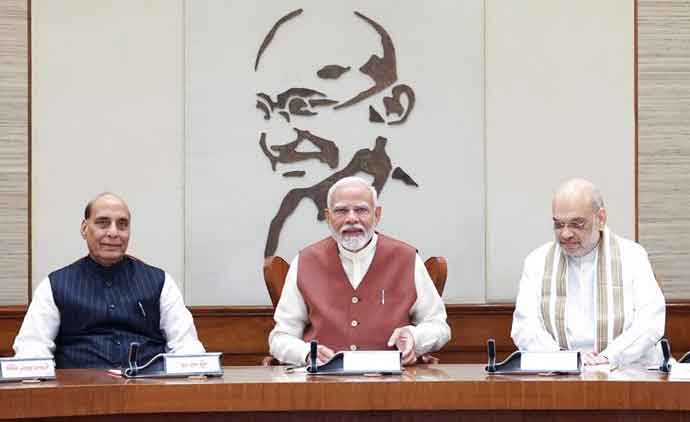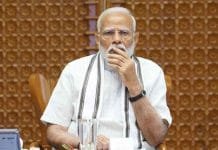INVC NEWS New Delhi — In a stunning and strategic counterstrike, India has avenged the brutal Pahalgam terror attack with a high-stakes military operation across the border, code-named Operation Sindoor. This mission, executed with surgical precision by the Indian Armed Forces, was not just a tactical retaliation—it was a personal directive from Prime Minister Narendra Modi, who not only authorized the attack but also personally named the operation in a top-secret high-level meeting held after the massacre in Pahalgam.
The Naming of ‘Operation Sindoor’: A Deep Symbol of National Resolve
The name ‘Operation Sindoor’ was not randomly selected—it carries a profound emotional and cultural significance. Following the heinous terrorist attack in Pahalgam that left several Indian soldiers dead, Prime Minister Modi convened a series of classified strategic meetings with the chiefs of the Army, Navy, and Air Force, along with key intelligence officials from RAW and IB.
According to highly placed sources, during one of these meetings, PM Modi passionately stated, “The terrorists have widowed our women and wiped away their sindoor. Our response must restore their pride.” This emotionally charged statement led him to personally coin the name ‘Operation Sindoor’, making it a symbol of vengeance, honor, and justice for the fallen.
The Secret Planning Room: Inside the Covert War Cabinet
In the days following the Pahalgam massacre, the Prime Minister held multiple war-room-style briefings in South Block, away from the media glare. The attendees included:
Chief of Defence Staff General Anil Chauhan
Army Chief General Manoj Pande
NSA Ajit Doval
RAW Chief Ravi Sinha
Air Force and Naval Commanders
These meetings were shrouded in secrecy. Devices were confiscated, electronic surveillance was disabled, and only handwritten notes were permitted. It was during one such classified strategic conclave that the blueprint for Operation Sindoor was finalized—an operation focused on swift, severe, and symbolic retaliation.
The Execution: Missile Rain on Terror Camps
Last night, under the veil of complete darkness and advanced satellite guidance, India launched a series of precision missile strikes deep inside Pakistan-occupied Kashmir (PoK) and across other strategic terror hubs in Pakistani territory. The mission targeted nine high-profile terrorist training camps and launch pads, which were confirmed to be sheltering and training operatives from Jaish-e-Mohammed, Hizbul Mujahideen, and Lashkar-e-Taiba.
Key Highlights of the Operation:
Over 250 terrorists eliminated, including senior commanders and trainers.
9 major camps destroyed, including operational HQs and logistic depots.
Zero civilian casualties, thanks to precision-targeting intelligence.
High-altitude drone surveillance provided real-time feedback for targeting.
Who Was Hit: Top Terror Leaders Eliminated
Among those neutralized in the strikes were notorious masterminds of cross-border terrorism:
Qari Naeem – Jaish’s weapons coordinator
Irfan Sheikh – Hizbul’s top recruiter in South Kashmir
Sajid Wani – Logistic head of the Pahalgam attack
These eliminations have crippled the operational backbone of the terrorist networks that have long operated with impunity in the region under Pakistani military patronage.
India’s Military Doctrine Has Evolved
Operation Sindoor reflects a paradigm shift in India’s counter-terror doctrine. No longer confined to reactive posturing, India has now adopted an offensive, pro-active strategy, signaling to the world that terrorism will be met with overwhelming force.
The operation marks a notable escalation in:
Cross-border engagement precision
Integration of intelligence and strike forces
Real-time coordination between Army, Air Force, and Special Ops units
The use of next-gen surveillance drones, hypersonic missile platforms, and satellite-guided weapon systems illustrates how India’s military is now tech-forward and tactically fearless.
PM Modi: A Leader of Iron Resolve
This operation reaffirms PM Narendra Modi’s uncompromising stand on national security. By personally overseeing the planning and naming of the operation, he has sent an unmistakable message to adversaries: India will retaliate with resolve, not rhetoric.
His leadership during these tense weeks has been described by insiders as “intensely hands-on.” From daily briefings with the NSA to direct conversations with field commanders, Modi’s war-room presence was not ceremonial—it was central.
Public Reaction: National Unity and Emotional Outpouring
Following the announcement of Operation Sindoor’s success, the country erupted in a wave of national pride and emotional catharsis. Families of the Pahalgam martyrs expressed a deep sense of closure. Citizens from across the nation took to the streets in impromptu patriotic gatherings, waving flags and chanting slogans in support of the armed forces.
Social media platforms were flooded with hashtags like #OperationSindoor, #ModiStrikesBack, and #AvengedPahalgam, with millions hailing the move as a turning point in India’s defense narrative.
Pakistan’s Response: Denial and Panic
As expected, Pakistan’s official stance was denial. Government spokespeople called the reports “Indian propaganda,” yet military hospitals in PoK reported a sudden influx of casualties. Furthermore, local sources confirmed aerial lockdowns, internet shutdowns, and emergency evacuations, suggesting that the impact of Operation Sindoor is undeniable, regardless of Islamabad’s posturing.
The Aftermath: India on High Alert
While Operation Sindoor has decimated enemy infrastructure, Indian defense forces are maintaining heightened vigilance. Countermeasures have been activated along the Western Front, with anti-drone systems, forward radar deployments, and naval warships on standby in the Arabian Sea.
The Ministry of Home Affairs has also issued alerts across metropolitan areas, pilgrimage routes, and critical infrastructure points, ensuring that internal security remains impenetrable.
Conclusion: Operation Sindoor Will Be Remembered in History
Operation Sindoor is a historic military triumph, a strategic masterstroke, and a national tribute. It encapsulates the pain of Pahalgam, the strength of India’s military, and the iron resolve of PM Modi’s leadership. By personally naming and overseeing the mission, Modi has given a new identity to India’s fight against terrorism—an identity rooted in dignity, culture, and unwavering justice.
This operation is not just about bombs and bunkers. It’s about restoring sindoor to the foreheads of Indian women whose husbands laid down their lives for the nation. It’s about telling the world that India does not forget—and it certainly does not forgive.















